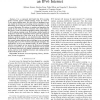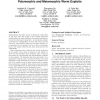29 search results - page 2 / 6 » Modeling and analysis of worm defense using stochastic activ... |
INFOCOM
2005
IEEE
13 years 10 months ago
2005
IEEE
— It is a commonly held belief that IPv6 provides greater security against random-scanning worms by virtue of a very sparse address space. We show that an intelligent worm can ex...
MOBICOM
2004
ACM
13 years 10 months ago
2004
ACM
Interactive communications among nodes in Vehicular Ad Hoc Networks (VANET) and the safety-oriented nature of many VANET applications necessitate a robust security framework. An a...
INFOCOM
2003
IEEE
13 years 10 months ago
2003
IEEE
— It has been clear since 1988 that self-propagating code can quickly spread across a network by exploiting homogeneous security vulnerabilities. However, the last few years have...
ESORICS
2006
Springer
13 years 8 months ago
2006
Springer
Abstract. Mix networks are a popular mechanism for anonymous Internet communications. By routing IP traffic through an overlay chain of mixes, they aim to hide the relationship bet...
CCS
2005
ACM
13 years 10 months ago
2005
ACM
Vulnerabilities that allow worms to hijack the control flow of each host that they spread to are typically discovered months before the worm outbreak, but are also typically disc...


